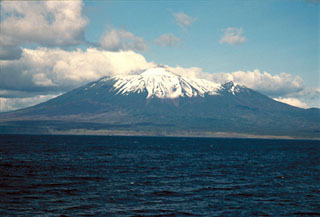Report on Chachadake [Tiatia] (Japan - administered by Russia) — December 1981
Scientific Event Alert Network Bulletin, vol. 6, no. 12 (December 1981)
Managing Editor: Lindsay McClelland.
Chachadake [Tiatia] (Japan - administered by Russia) Moderate fumarolic activity from the summit crater
Please cite this report as:
Global Volcanism Program, 1981. Report on Chachadake [Tiatia] (Japan - administered by Russia) (McClelland, L., ed.). Scientific Event Alert Network Bulletin, 6:12. Smithsonian Institution. https://doi.org/10.5479/si.GVP.SEAN198112-290030
Chachadake [Tiatia]
Japan - administered by Russia
44.353°N, 146.252°E; summit elev. 1822 m
All times are local (unless otherwise noted)
"Aerial inspection on 20 September of the volcanoes in the S and central Kuril Islands revealed that Tiatia's summit crater was in a state of moderate fumarolic activity. No individual distinct fumaroles were observed; vapor was being released from the whole crater surface. Numerous vapor sites were also noticed on the outer slopes near the summit crater. There were no remarkable changes near the volcano summit as compared to 1977-78. A certain increase in heat activity was observed near the subordinate vent (formed in 1973) on the S slope. Heat flow measurements made in the vent in 1981 by A. Zemtsov and A. Tron yielded values of q = 7.4 and W/m2 = 1.77 cal/cm2s, 1.2 times as large as in 1978. Orange glare was observed by people in Yuzhno-Kurilsk, 50 km SW of the volcano, but we are not sure that it was related to volcanic activity."
Geological Summary. The symmetrical Chachadake, also known as Tiatia, is on the SE side of northern Kunashir Island in the southern Kuriles. The active cone rises above the rim of a filled 2.1 x 2.4 km summit caldera with erosionally furrowed flanks. The central cone, mostly formed by basaltic to basaltic andesite Strombolian eruptions, rises 400 m above the floor of the caldera and contains a 400 x 250 m wide crater with two explosion vents separated by a linear septum. Fresh lava flows cover much of the SW caldera floor and have overflowed the rim, extending to the foot of the older edifice, which formed during the late Pleistocene or early Holocene. A 500-m-wide crater about 2 km down the SE flank from the caldera rim is surrounded by an unvegetated area of volcanic deposits. The first recorded eruption was in 1812, and a major explosive eruption with lava flows in 1973 originated from vents on the central cone.
Information Contacts: G. Steinberg, Sakhalin Complex Institute.

